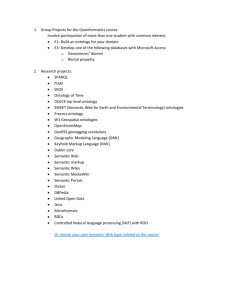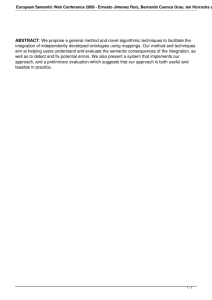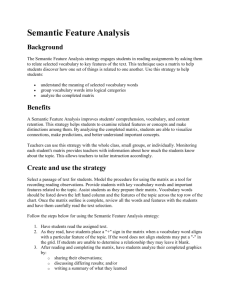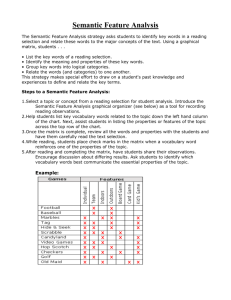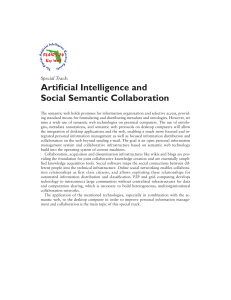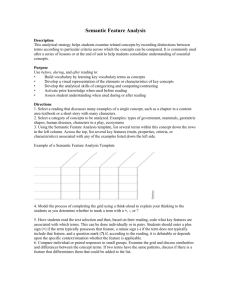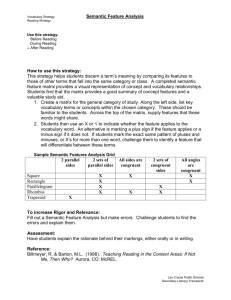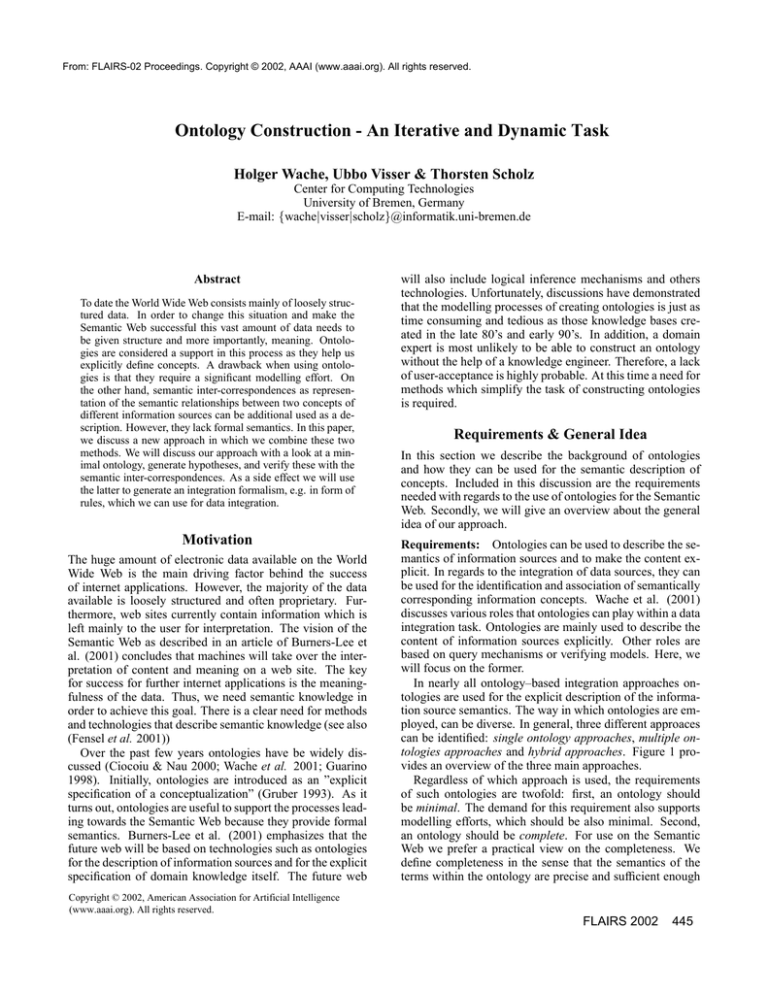
From: FLAIRS-02 Proceedings. Copyright © 2002, AAAI (www.aaai.org). All rights reserved.
Ontology Construction - An Iterative and Dynamic Task
Holger Wache, Ubbo Visser & Thorsten Scholz
Center for Computing Technologies
University of Bremen, Germany
E-mail: {wache|visser|scholz}@informatik.uni-bremen.de
Abstract
To date the World Wide Web consists mainly of loosely structured data. In order to change this situation and make the
Semantic Web successful this vast amount of data needs to
be given structure and more importantly, meaning. Ontologies are considered a support in this process as they help us
explicitly define concepts. A drawback when using ontologies is that they require a significant modelling effort. On
the other hand, semantic inter-correspondences as representation of the semantic relationships between two concepts of
different information sources can be additional used as a description. However, they lack formal semantics. In this paper,
we discuss a new approach in which we combine these two
methods. We will discuss our approach with a look at a minimal ontology, generate hypotheses, and verify these with the
semantic inter-correspondences. As a side effect we will use
the latter to generate an integration formalism, e.g. in form of
rules, which we can use for data integration.
Motivation
The huge amount of electronic data available on the World
Wide Web is the main driving factor behind the success
of internet applications. However, the majority of the data
available is loosely structured and often proprietary. Furthermore, web sites currently contain information which is
left mainly to the user for interpretation. The vision of the
Semantic Web as described in an article of Burners-Lee et
al. (2001) concludes that machines will take over the interpretation of content and meaning on a web site. The key
for success for further internet applications is the meaningfulness of the data. Thus, we need semantic knowledge in
order to achieve this goal. There is a clear need for methods
and technologies that describe semantic knowledge (see also
(Fensel et al. 2001))
Over the past few years ontologies have be widely discussed (Ciocoiu & Nau 2000; Wache et al. 2001; Guarino
1998). Initially, ontologies are introduced as an ”explicit
specification of a conceptualization” (Gruber 1993). As it
turns out, ontologies are useful to support the processes leading towards the Semantic Web because they provide formal
semantics. Burners-Lee et al. (2001) emphasizes that the
future web will be based on technologies such as ontologies
for the description of information sources and for the explicit
specification of domain knowledge itself. The future web
will also include logical inference mechanisms and others
technologies. Unfortunately, discussions have demonstrated
that the modelling processes of creating ontologies is just as
time consuming and tedious as those knowledge bases created in the late 80’s and early 90’s. In addition, a domain
expert is most unlikely to be able to construct an ontology
without the help of a knowledge engineer. Therefore, a lack
of user-acceptance is highly probable. At this time a need for
methods which simplify the task of constructing ontologies
is required.
Requirements & General Idea
In this section we describe the background of ontologies
and how they can be used for the semantic description of
concepts. Included in this discussion are the requirements
needed with regards to the use of ontologies for the Semantic
Web. Secondly, we will give an overview about the general
idea of our approach.
Requirements: Ontologies can be used to describe the semantics of information sources and to make the content explicit. In regards to the integration of data sources, they can
be used for the identification and association of semantically
corresponding information concepts. Wache et al. (2001)
discusses various roles that ontologies can play within a data
integration task. Ontologies are mainly used to describe the
content of information sources explicitly. Other roles are
based on query mechanisms or verifying models. Here, we
will focus on the former.
In nearly all ontology–based integration approaches ontologies are used for the explicit description of the information source semantics. The way in which ontologies are employed, can be diverse. In general, three different approaces
can be identified: single ontology approaches, multiple ontologies approaches and hybrid approaches. Figure 1 provides an overview of the three main approaches.
Regardless of which approach is used, the requirements
of such ontologies are twofold: first, an ontology should
be minimal. The demand for this requirement also supports
modelling efforts, which should be also minimal. Second,
an ontology should be complete. For use on the Semantic
Web we prefer a practical view on the completeness. We
define completeness in the sense that the semantics of the
terms within the ontology are precise and sufficient enough
Copyright © 2002, American Association for Artificial Intelligence
(www.aaai.org). All rights reserved.
FLAIRS 2002
445
Figure 1: The three possible ways for using ontologies for
content explication
for the interpretation requirements of the machines running
on the Semantic Web. To have a complete ontology is an
extremely difficult task. It can only be verified by domain
experts and use over a certain amount of time. Therefore,
these two requirements are orthogonal and there is a clear
trade-off between minimalism on one hand and completeness on the other.
General idea: The obvious and practical process in the
development of a complete and minimal ontology is, to start
with a small ontology and extend it to completion. However,
how can we determined the completeness of an ontology?
Our basic idea of determining the completeness of an
ontology is to apply an additional and different approach
for specification of the meaning of concepts. Such a semantic description specifies directly the semantic intercorrespondences of terms from different sources rather than
relating each of them to an ontology and then comparing the
relationships. Semantic inter-correspondences are the representation of the semantic relationship between two concepts from different information sources. They are means
to describe the semantic differences between the concepts.
This different semantic description can be used to verify the
completeness (and correctness) of the ontology. Examples
of how semantic inter-correspondences can be achieved can
be found in (Naiman & Ouksel 1995; Parent & Spaccapietra
1998; Kashyap & Sheth 1996).
With respect to the requirements mentioned above we argue that an ontology can be verified if we know the semantic inter-correspondences between concepts described in the
ontology. The drawback of only having an ontology is that
we have problems with the completeness and the drawback
of having only semantic inter-correspondences is that they
don’t have explicit semantics. Therefore, we argue that a
combination of both approaches would relax the problems
mentioned.
and then discuss the statements in more detail.
Construct initial ontology
repeat
Extend ontology
Use this ontology to generate hypothesis for semantic
inter-correspondences
Validate and develop semantic inter-correspondences
to verify ontology
until ontology is complete
We start this method with a very simple domain terminology which gradually becomes refined during the verification process. This method not only reduces start-up costs,
but captures the very subtle differences in the underlying information sources. Application ontologies do not require
global agreements from all sources, which further simplifies their development. In order to make the application ontologies comparable, they use a common global vocabulary
organized in a terminology (see section 1). This method is
reiterated several times until the author of the ontology becomes satisfied with the ontologies degree of completeness.
1. The first step of the process is the acquisition of the semantics of each information source. These sources are
described separately without the consideration of other
sources. Once this step is completed we can use inference mechanisms of underlying machines to generate a
hypothesis which are hidden in the ontology.
2. In the next step we considered the relationship to other
sources. For semantic description, a concept from different information sources is labelled with terms from a
common domain terminology. This implies the acquisition of its application ontology. In the second step, concepts from different sources are semantically compared.
These two concepts are related with so-called semantic
inter-correspondences that estimate their semantic difference.
Please note that these two kinds of semantics, the domain
semantics and the semantic differences, correlate because
they are acquired separately in two steps and can be verified against each other. Figure 2 demonstrates the overall
process. Task A represents the development of a minimal
ontology whereas task B represents the correspondence in
regards to semantic inter-correspondences. The next question is: How do we construct a minimal ontology, which
An Ontology Construction Method
In this section, we describe the method of how we can construct an ontology that holds the requirements we mentioned
in the previous section. First we will describe the algorithm
446
FLAIRS 2002
Figure 2: Ontology construction method
Complex terms (l)
l1 u l 2
l1 t l 2
¬l1
l1 B l 2
l1 ⊕ l 2
ASCII
(AND l1 l2 )
(OR l1 l2 )
(NOT l1 )
(l1 OF l2 )
(COMP l1 l2 )
Π(l) 7→ Concept Term
l 1 u l2
l 1 t l2
¬l1
l1 u ∃to.l2
∃has-part.l1 u ∃has-part.l2
Interpretation (Π(l))I
l1I ∩ l2I
l1I ∪ l2I
U \ l1I
l1I ∩ {k I |∃k I : (k I , l2I ) ∈ toI }
{k1I |∃k1I : (k1I , l1I ) ∈ has-partI }∩
{k2I |∃k2I : (k2I , l2I ) ∈ has-partI }
Table 1: Complex terms and their corresponding terms in description logics
tools do we use in the process and how do we find semantic
inter-correspondences?
M E SA
The proposed ontology construction method is implemented
in a tool called MEdiator Specification Assistant (M E SA).
In the following subsections we describe the hybrid ontology
approach in M E SA and how ontologies can be constructed
for information sources. We also discuss which kind of semantic inter-correspondences are supported and how these
different kinds of semantic description interact.
A concept defined in an information source represents a
set of all possible instances in the database. Each instance
of this concept represents a real-world object. For the semantic description, we focus on real-world objects which
provide the semantic basis for the concepts. In the follwing
the objects will be referred as extensions of the concept.
The hybrid ontology approach in M E SA
M E SA follows the hybrid ontology approach (see figure 1c),
which means that an application ontology is constructed for
each information source. The terms for the ontologies consists of terms from a global terminology. The global terminology can be seen as a set of primitive terms of a domain. Primitive terms in a financial domain for example can
be ”stock” or ”price”. These primitive terms can be combined to complex terms with the help of combination operators (Wache et al. 1999). The combination operators (e.g.
AND, OR, and NOT) are well-known from description logics
but are extended for other purposes, e.g. in the area of information integration. With the help of the OF-operator, for
example, primitive terms ”price” and ”stock” can be combined to the complex term ”price-OF-stock” indicating that
the primitive term ”price” is refined to a price of stocks.
All operators can be modelled in description logics (see
table 1). Therefore, it is possible to compare complex terms,
i.e. it can be inferred if one complex term is a specialization of another or two complex terms are disjoint or overlap.
A detailed definition of the combination operators and their
semantics can be found in (Wache et al. 1999).
In order to explicitly specify the semantics of a concept
in an information source, a function L can be established
which maps a concept C of a source to its complex term
L(C) = l. The function can also be viewed as a annotation
process of the concept with a semantic description. We call
such an annotation L(C) semantic label (or label, shortly)
in M E SA.
Defining labels according to the structure of a concept
leads to a combination of complex terms. I.e. the relations
of a concept C to other concepts Ci – the structure of the
concept – can be used to arrange the labels of C and Ci in
the same way. These arranged labels build the application
ontology. Please note that each information source can arrange the same complex terms in different ways reflecting
the fact that each information source arrange their information in different ways.
In the first step of the ontology construction method the
user starts with a small set of the most important primitive
terms and annotates the real-world objects with labels, i.e.
the combined primitive terms. If more primitive terms are
needed the user can extend the terminology. Furthermore,
the user only has to annotate one information source without
any respect to other information sources. The relationship
between concepts of different information sources is the task
of the semantic inter-correspondences.
Semantic inter-correspondences in M E SA
We define semantic inter-correspondences between concepts
C1 and C2 based on their extensions as mentioned above.
These extensions E(C) of a concept C are defined as the
set of real world objects, represented by C. As these
sets cannot be captured automatically, the semantic intercorrespondences rely strongly on the specification of the
user who should analyze the extensions of the concepts in
the corresponding information sources. The reflection of
whether two extensions of concepts of different information
sources represent the same real-world objects can only be
done by a domain expert. Based on these extensions, we
classify four semantic inter-correspondences between two
concepts C1 and C2 (Spaccapietra, Parent, & Dupont 1992):
• Semantic equivalence C1 ≡ C2 : The concepts C1 and
C2 represent the same set of real-world objects, E(C1 ) =
E(C2 ).
• Semantic subsumption C1 ⊂ C2 : The set of real-world
objects represented by the concept C1 is a subset of the
set represented by C2 , E(C1 ) ⊂ E(C2 ).
• Semantic intersection C1 ∩ C2 : The sets of real-world
objects represented by the concepts C1 and C2 overlap
partially, while E(C1 ) 6⊂ E(C2 ) and E(C2 ) 6⊂ E(C1 ),
so that there is a real intersection between the extensions
of the concepts, E(C1 ) ∩ E(C2 ).
• Semantic incompatibility C1 6= C2 : The sets of realworld objects E(C1 ) and E(C2 ) are completely disjunc-
FLAIRS 2002
447
Semantic Inter-Correspondences
Labels
L(C1 ) ≡ L(C2 )
C1 ≡ C2
C1 ⊂ C2
C1 ∩ C2
OK
specialize L(C1 ) or
generalize L(C2 )
specialize
L(C1 )
and L(C2 )
specialize L(C2 ) or
generalize L(C1 )
C1 6= C2
error
L(C1 ) ∩ L(C2 )
specialize L(C2 ) or
generalize L(C1 )
specialize
L(C1 )
and L(C2 )
specialize L(C1 ) or
generalize L(C2 )
OK
disjoint L(C1 ) and
L( C2 )
L(C1 )¬L(C2 )
error
error
disjoint L(C1 ) and
L(C2 )
OK
L(C1 ) ⊂ L(C2 )
OK
error
Table 2: Verifying labels with semantic inter-correspondences
tive, therefore C1 and C2 represent different real-world
objects.
These four classes of semantic inter-correspondences are
sufficient to describe the relationship between two concepts
of different information sources. These classes are defined
similar to the common set operators for relations between
sets. However, there are also other approaches for modelling
relationships between concepts, such as semantic proximity
by Kashyap & Sheth (1996). The semantic proximity defines the semantic relationship between two concepts based
on a context and the level of abstraction between compared
concepts. The inter-schema correspondence assertions by
Naiman & Ouksel (1995) is another approach, which uses
levels of abstraction as well as levels of heterogeneity between compared concepts.
One reason for using the semantic inter-correspondences
approach in M E SA is its simplicity. The approach also has
the lowest modelling effort if compared to the other approaches.
Verify ontology with semantic intercorrespondences
The labels and the semantic inter-correspondences are in
close relationship to each other since labels can be verified
by the semantic inter-correspondences. The user establishes
semantic inter-correspondences considering the extensions
of the concepts instead of considering the labels. If the semantic inter-correspondences are established between two
concepts C1 and C2 , there might be differences between the
semantic inter-correspondences and the labels of the concepts. Assuming that a previously defined semantic intercorrespondence is correct, table 2 shows which label has to
be modified and how. Disjoint labels or semantic incompatibility indicates a modelling error. Therefore, the labels and
the semantic inter-correspondences must be checked. In all
other cases it is sufficient to refine one or both labels. A
refinement is done by specializing or generalizing. A specializing process is done by choosing another primitive term
from the terminology or by creating a new primitive term,
which is then added to the terminology. The primitive term
could either replace the old label of the concept or could be
used to extend the label with one of the given combination
448
FLAIRS 2002
operators. In case of generalization a label must be simplified by deleting some primitive terms. After a refinement the
semantic inter-correspondences has to be validated with respect to the refined label(s). This refinement and validation
process re-iterates until the semantic inter-correspondences
and the label relationships harmonize (diagonal in table 2).
From a logical point of view, the labels are interpreted as
a set in a universe. Comparing the labels of two concepts
means comparing their two sets in the universe. The semantic inter-correspondences also compares two sets of extensions. Extensions are the real world objects and therefore
can be seen as a ”given” universe. If we compare the relationship between two label sets and two extension sets (as in
table 2), we verify whether the relationship between the label sets includes the relationship of the extensions. In other
words, table 2 compares two relationships of model sets.
Supporting the Knowledge Engineer
One can argue that the additional modelling effort is too tedious within the acquisition phase of an ontology and that
the practical relevance is low. However, we can use logical
reasoning methods to support the process. The specification of the semantic inter-correspondences can be simplified
by using the principle of abduction for finding them. The
implication that a semantic inter-correspondence between
two concepts requires certain labels for the concepts can
be used in the inverse direction by abducting the semantic inter-correspondences from the labels. If the concepts
in information sources have been labelled previously, these
labels could be used to create a hypothesis on how the relationship between concepts of different sources might be
and thus define the semantic inter-correspondences. This
process could be supported by a software assistant, which
automatically creates the hypothesis for the semantic intercorrespondences. Such an assistant has been developed and
implemented in the M E SA system, offering the possibility
to find semantic inter-correspondences in pre-labelled information sources.
In a financial domain for example two concepts C1 and
C2 of different sources represent information about securities. Both concepts can be annotated with the label ”security”. In the real world though C1 only represents stocks.
The knowledge engineer usually focusses on one informa-
tion source while constructing an ontology and would miss
the difference. Furthermore, it is practically impossible for
the knowledge engineer to have all concepts of all sources
in mind. Therefore it is reasonable to annotate C1 only
with ”security” omitting further details. M E SA, however,
can suggest the hypothesis that C1 and C2 are semantically equivalent C1 ≡ C2 because they have the same labels (L(C1 ) ≡ L(C2 )). In the verification process the domain expert needs to verify the generated semantic intercorrespondence. If he decides that C1 is a subset of C2
(C1 ⊂ C2 ) the mismatch becomes obvious and the engineer has to specialize the label of C1 (L(C1 )) or generalize
the label of C2 (L(C2 )).
Configuring an Integration system
Additionally we can use the semantic inter-correspondences
to achieve interoperability between systems using the developed ontology. Once we have developed semantic intercorrespondences we are able to generate an integration formalism in form of propositional rules. A number of systems
in the area of intelligent information integration, are using
this kind of rules (Chawathe et al. 1994; Wache & Stuckenschmidt 2001).
Conclusion
Both the ontology-driven approach and the semantic intercorrespondences approach can be used to define semantical
knowledge needed for the Semantic Web. However, these
approaches are labor-intensive and are therefore serious obstacles to their widespread use. One can use both approaches
on their own to fulfil the needs of the Semantic Web and both
approaches are useful means to support the development of
methods towards the activity with respect to the World Wide
Web.
In this paper, we have proposed a new approach to gradually develop a domain ontology and to acquire semantic
inter-correspondences at the same time. The combination of
these two approaches provides us with an ontology, which
is complete, an important if not necessary property. We argue that the integration of these two approaches is even better than the single approaches due to the completeness of
the ontology. In contrary, one can argue that the demand of
minimalization is not fulfilled. The opposite is true: we start
with a minimal ontology and use inference mechanisms to
derive hidden knowledge. This knowledge can be verified by
a domain expert who at the same time is defining semantic
inter-correspondences between terms. This will lead to new
knowledge of the domain and the process starts again. We
think that the demand of minimalization is fulfilled. Given
the fact that we would like to develop a complete and minimal ontology this would be one way to achieve the goal.
The approach also allows the support of software assistants, which can help to acquire and verify the semantics
of information sources. M E SA is such an assistant for the
knowledge acquisition process. It supports both the domain
expert and the knowledge engineer. This tool is not only
a comfortable graphical interface, it also suggests semantic
inter-correspondences by an inference mechanism. Both the
method and the tool are helpful means in order to make the
vision of the Semantic Web a reality.
References
Bernes-Lee, T.; Hendler, J.; and Lassila, O. 2001. The
semantic web. Scientific American (5).
Chawathe, S.; Garcia-Molina, H.; Hammer, J.; Ireland, K.;
Papakonstantinou, Y.; Ullman, J.; and Widom, J. 1994. The
tsimmis project: Integration of heterogeneous information
sources. In Conference of the Information Processing Society Japan, 7–18.
Ciocoiu, M., and Nau, D. S. 2000. Ontology-based semantics. In Knowledge Representation (KR).
Fensel, D.; Harmelen, F. v.; Horrocks, I.; McGuinness,
D. L.; and Patel-Schneider, P. F. 2001. Oil: An ontology infrstructure for the semantic web. IEEE Intelligent
Systems 16(2):38–44.
Gruber, T. 1993. A translation approach to portable ontology specifications. Knowledge Acquisition 5(2):199–220.
Guarino, N. 1998. Formal ontology and information systems. In Guarino, N., ed., FOIS 98. Trento, Italy: IOS
Press.
Kashyap, V., and Sheth, A. 1996. Schematic and semantic semilarities between database objects: A context-based
approach. The International Journal on Very Large Data
Bases 5(4):276–304.
Naiman, C. F., and Ouksel, A. M. 1995. A classification
of semantic conflicts in heterogeneous database systems.
Journal of Organizational Computing 167–193.
Parent, C., and Spaccapietra, S. 1998. Issues and approaches of database integration. Communications of the
ACM 41(5):166–178.
Spaccapietra, S.; Parent, C.; and Dupont, Y. 1992. Model
independent assertions for integration of heterogeneous
schemas. VLDB Journal: Very Large Data Bases 1(1):81–
126.
Wache, H.; Scholz, T.; Stieghahn, H.; and König-Ries,
B. 1999. An integration method for the specification of
rule–oriented mediators. In Kambayashi, Y., and Takakura,
H., eds., Proceedings of the International Symposium on
Database Applications in Non-Traditional Environments
(DANTE’99), 109–112.
Wache, H.; Vögele, T.; Visser, U.; Stuckenschmidt, H.;
Schuster, G.; Neumann, H.; and Hübner, S. 2001.
Ontology-based integration of information - a survey of existing approaches. In Stuckenschmidt, H., ed., IJCAI-01
Workshop: Ontologies and Information Sharing, 108–117.
Wache, H., and Stuckenschmidt, H. 2001. Practical context transformation for information system interoperability.
In Akman, V.; Bouquet, P.; Thomason, R.; and Young, R.,
eds., Modeling and Using Context, volume 2116 of Lecture notes in AI. Proceedings of the Third International and
Interdisciplinary Conference, CONTEXT, Dundee, UK:
Springer Verlag. 367–380.
Wiederhold, G. 1992. Mediators in the architecture of
future information systems. IEEE Computer 25(3):38–49.
FLAIRS 2002
449

